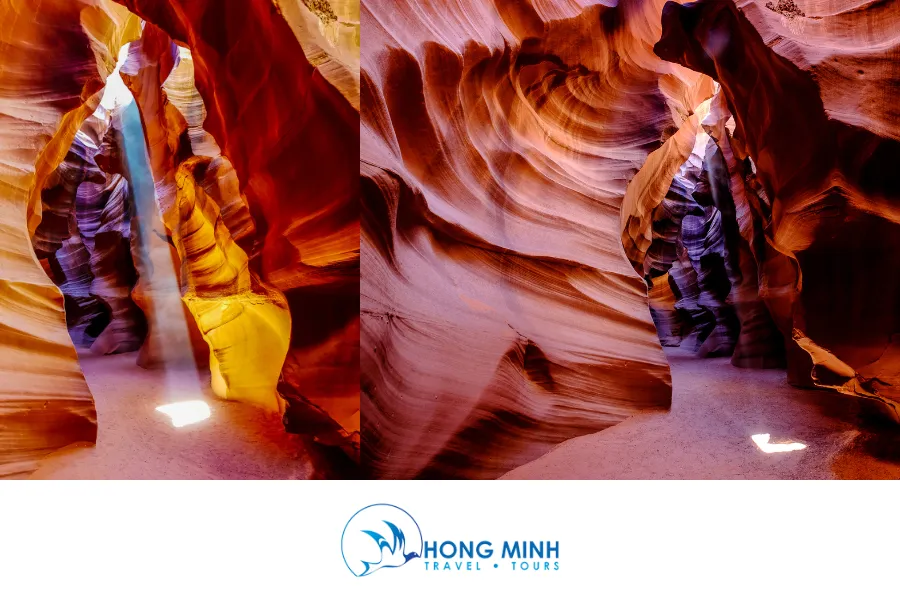Have you ever dreamed of stepping into a magical land where light and rock intertwine to create surreal works of art? Come to Antelope Canyon in Utah, USA, a must-visit destination for those passionate about photography and exploring the unique beauty of nature.
The journey to discover Antelope Canyon is not just a trip, but a mesmerizing visual experience. Here, you will witness soft, flowing sandstone walls, sculpted by wind and water over millions of years. Sunlight filters through narrow crevices, creating vibrant, ever-changing colors, from orange, red, yellow to purple, and blue.
Antelope Canyon: A Photographer’s Paradise in the Utah Desert
Antelope Canyon, also known as the Corkscrew Canyon, is a natural wonder located near Page, Arizona, but within Utah, USA. It is famous for the unique beauty of sandstone walls intricately carved by nature over millions of years. Sunlight shines into the canyon through openings at the top, creating magical, constantly changing colors that will amaze anyone who sets foot here.
The Geological History of Antelope Canyon
Antelope Canyon was formed by the erosion of Navajo sandstone due to water and wind over millions of years. During the rainy season, flash floods rush into the canyon, carrying sand and rocks, eroding the canyon walls, creating soft curves and bizarre shapes. This process has continued over time, creating a unique and beautiful canyon as it is today.
Two Sections of Antelope Canyon: Upper and Lower
Antelope Canyon is divided into two main sections: Upper Antelope Canyon (Tsé bighánílíní) and Lower Antelope Canyon (Hazdistazí).
- Upper Antelope Canyon (Tsé bighánílíní): Famous for the light beams that appear at midday, especially in the summer. This is an ideal location for photographers who want to capture impressive photos with natural light.
Sunlight beams shining through the narrow opening of Upper Antelope Canyon, Utah
- Lower Antelope Canyon (Hazdistazí): Narrower and has steeper stairs than Upper Antelope Canyon. However, Lower Antelope Canyon has more beautiful shooting angles and is less affected by direct light, suitable for those who want to explore and take pictures in a quieter space.
Photography Experience at Antelope Canyon
Pre-Trip Preparation:
- Book a tour in advance: Due to the limited number of visitors to protect the canyon, you should book a tour in advance, especially during peak season.
- Choose the right time: The best time to visit Antelope Canyon is at midday (from 11:00 AM to 1:00 PM) when sunlight shines directly into the canyon, creating magical light beams.
- Prepare equipment:
- Camera: A DSLR or mirrorless camera with a wide-angle lens is the best choice for capturing panoramic canyon views.
- Tripod: A tripod helps you take sharper photos in low light conditions.
- Cleaning cloth: Bring a cleaning cloth to protect your camera from dust and sand.
- Water and snacks: Make sure you have enough energy throughout the trip.
- Clothing: You should wear comfortable, easy-to-move clothing and hiking shoes or sneakers with good grip.
During the Tour:
- Follow the Navajo guide’s instructions: The Navajo people own Antelope Canyon, and they have their own regulations to protect the canyon. Follow their instructions to ensure safety and environmental protection.
- Taking photos:
- Use manual mode to control light and aperture.
- Look for unique shooting angles: Antelope Canyon has countless beautiful shooting angles, take time to explore and find the most impressive ones.
- Capture photos with different color ranges: The light in Antelope Canyon changes constantly, creating different color ranges. Take photos with different color ranges to create vibrant images.
Tips for Taking “Instagrammable” Photos at Antelope Canyon
- Utilize Natural Light: Light is the most important element to create beautiful photos at Antelope Canyon. Utilize natural light to highlight the beauty of the canyon.
- Find Impressive Details: In addition to the sandstone walls, Antelope Canyon also has many other impressive details such as streaks, bizarre shapes, or small grains of sand. Find these details and incorporate them into your photos.
- Use HDR Photography Technique: HDR (High Dynamic Range) photography technique helps you capture high-contrast photos, preserving details in both bright and dark areas.
- Experiment with Different Shooting Angles: Don’t be afraid to experiment with different shooting angles to find the most unique and impressive perspectives.
Other Tourist Destinations Near Antelope Canyon
In addition to Antelope Canyon, this area also has many other attractive tourist destinations that you can combine visiting:
- Horseshoe Bend: A horseshoe-shaped meander of the Colorado River, creating a majestic landscape.
- Lake Powell: A vast artificial lake where you can participate in activities such as swimming, kayaking, and fishing.
Panoramic view of Horseshoe Bend, a horseshoe-shaped meander of the Colorado River
- Monument Valley: A valley with giant sandstone buttes, which was the setting for many Western cowboy movies.
- Zion National Park & Bryce Canyon National Park: Two famous national parks with majestic canyons and unique rock formations.
Conclusion
Experiencing Utah antelope photography at Antelope Canyon is an unforgettable journey for anyone who loves photography and exploring natural beauty. From the magical light beams to the soft sandstone walls, this place offers countless opportunities for you to unleash your creativity and capture memorable moments. Plan your trip today and discover the captivating beauty of Antelope Canyon!

 Panoramic view of Horseshoe Bend, a horseshoe-shaped meander of the Colorado River
Panoramic view of Horseshoe Bend, a horseshoe-shaped meander of the Colorado River